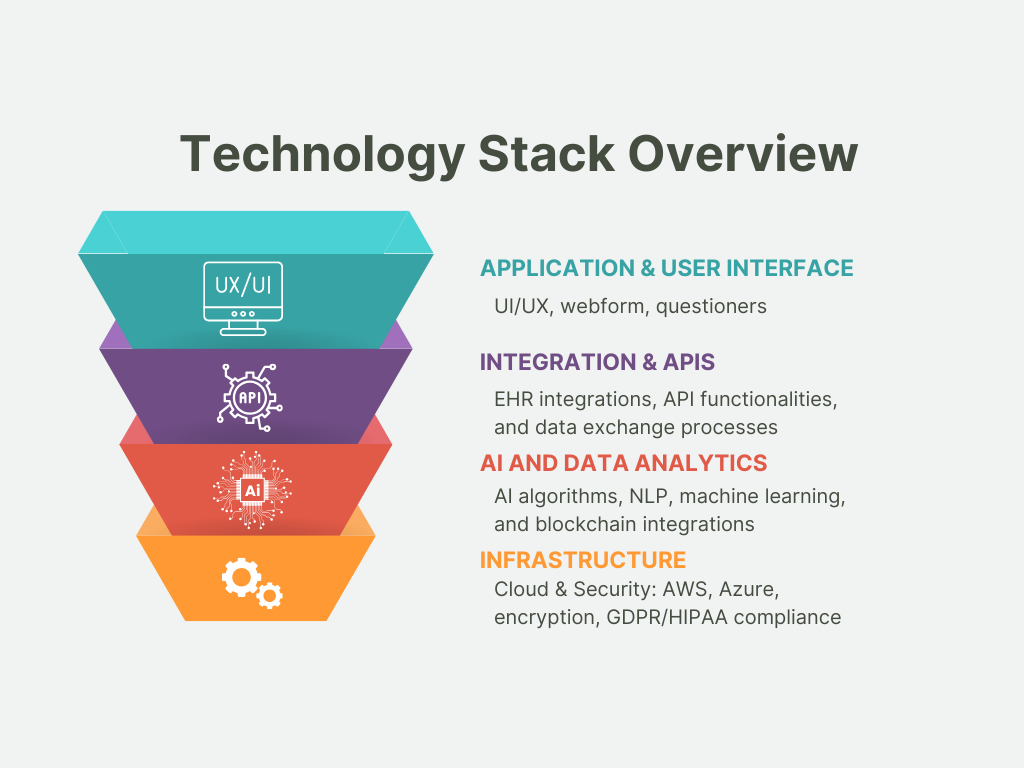Technology Stack Overview for Trial Match

At the heart of Trial Match’s platform is a robust and scalable technology stack that integrates multiple layers of cutting-edge technologies. These include:
- Artificial Intelligence (AI): Machine learning algorithms and Natural Language Processing (NLP) to enhance patient recruitment, trial optimization, and data-driven decision-making.
- Data Analytics and Predictive Modeling: A comprehensive analytics engine that provides real-time insights and forecasts based on large datasets.
- Cloud Infrastructure: A scalable cloud-based architecture that ensures seamless operation across multiple geographic locations, compliant with regional regulations like HIPAA, GDPR, and PIPEDA.
- Security and Compliance Framework: Built-in security protocols that ensure data privacy and protection, including encryption, anonymization, and regulatory compliance tools.
- API and Integration: Secure and interoperable APIs that integrate with Electronic Health Records (EHR) systems, hospital databases, and other third-party services for seamless data exchange.
- User Interface (UI) and Experience (UX): A patient-centric design that makes the platform intuitive and user-friendly, ensuring higher engagement and retention rates among participants.
The AI algorithms used in Trial Match are critical to its ability to optimize patient recruitment, trial management, and data-driven decision-making. Here’s a detailed breakdown of the specific AI algorithms integrated into the platform:
AI Algorithms Driving Clinical Trial Optimization
Trial Match harnesses advanced AI algorithms to revolutionize patient recruitment, engagement, and clinical trial management. By integrating Natural Language Processing (NLP), Machine Learning, Deep Learning, Reinforcement Learning, Ensemble Learning, and Anomaly Detection techniques, Trial Match delivers a data-driven, efficient, and adaptive solution tailored to the complexities of clinical trials. Here’s a detailed breakdown of the AI algorithms that power this platform:
- Named Entity Recognition (NER): This algorithm identifies and extracts relevant medical terms, patient information, and clinical trial requirements from unstructured data sources, such as Electronic Health Records (EHRs), medical notes, and trial protocols. It helps match eligible patients with appropriate trials based on specific criteria like medical history, demographic details, and diagnosis.
- Topic Modeling (LDA – Latent Dirichlet Allocation): Used to categorize and analyze unstructured text data from patient surveys, feedback, and trial protocols, helping to identify common themes, concerns, or opportunities for improvement in patient recruitment strategies.
- Sentiment Analysis: This algorithm evaluates patient feedback, social media interactions, and survey responses to understand patient sentiment and engagement levels, allowing the platform to tailor communication strategies accordingly.
- Random Forest: Employed for patient matching, this ensemble learning algorithm analyzes various features (e.g., age, medical history, lifestyle factors) to predict the likelihood of a patient being eligible and suitable for a particular clinical trial. It helps improve the accuracy and efficiency of patient recruitment.
- Gradient Boosting Machines (GBM): This algorithm is used to enhance patient retention and predict patient dropout rates by analyzing historical data, patient demographics, and trial engagement metrics. It enables proactive measures to be taken to improve retention.
- Support Vector Machines (SVM): Used for classifying patient eligibility based on complex, multi-dimensional criteria. SVM is particularly effective in handling high-dimensional data, making it useful for analyzing patient medical records, lab results, and trial criteria.
- K-Means Clustering: This unsupervised learning algorithm is used to segment patients into distinct clusters based on similar characteristics (e.g., health conditions, demographics, trial responses). It aids in identifying target groups for recruitment and understanding patient profiles for more personalized communication.
- Convolutional Neural Networks (CNNs): Applied in analyzing medical imaging data (e.g., X-rays, MRIs) to identify eligible patients for trials that require specific medical conditions or characteristics. This helps broaden the reach of patient recruitment by including patients who might otherwise be missed.
- Recurrent Neural Networks (RNNs) with LSTM (Long Short-Term Memory): Used to analyze time-series data such as patient monitoring reports, health metrics over time, and trial progress. This is especially valuable for predicting patient outcomes and engagement trends throughout the trial period.
- Q-Learning: Utilized to optimize trial management by dynamically adjusting recruitment strategies based on real-time data. For example, the system can learn which channels or methods yield the highest patient enrollment rates and adapt its strategies to maximize efficiency.
- Multi-Armed Bandit Algorithms: Used for A/B testing various recruitment and engagement strategies to determine the most effective approach in real-time. This ensures that the platform continuously improves patient recruitment and retention rates by focusing on the most successful methods.
- Stacking and Blending: Trial Match combines predictions from multiple models (e.g., Random Forest, SVM, Gradient Boosting) to improve the overall accuracy and reliability of patient matching and recruitment predictions. This approach ensures that the system benefits from the strengths of various algorithms.
- Isolation Forest: Used for identifying irregularities in patient data, such as inconsistencies in medical records or unexpected changes in trial engagement patterns. This helps maintain data quality and identify potential issues early in the recruitment process.
- Autoencoders: Applied in identifying anomalies in large datasets related to patient behavior, trial outcomes, or data entry errors, ensuring data integrity and enabling quick intervention when needed.
These AI algorithms work together to provide a robust and adaptive system for patient recruitment, engagement, and trial optimization. Trial Match’s use of advanced AI technologies enables it to outperform competitors by delivering accurate, efficient, and data-driven solutions tailored to the needs of clinical trials.
